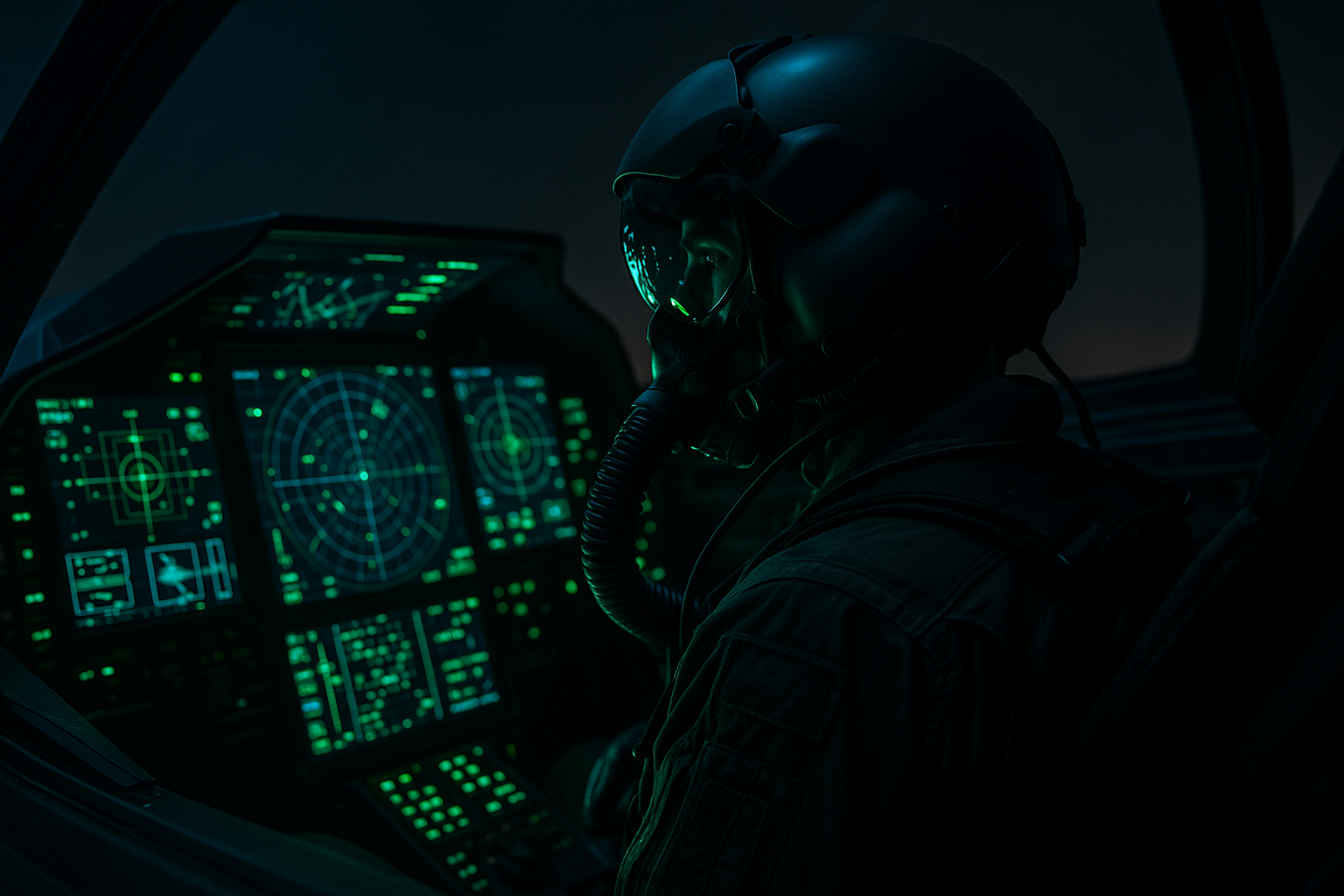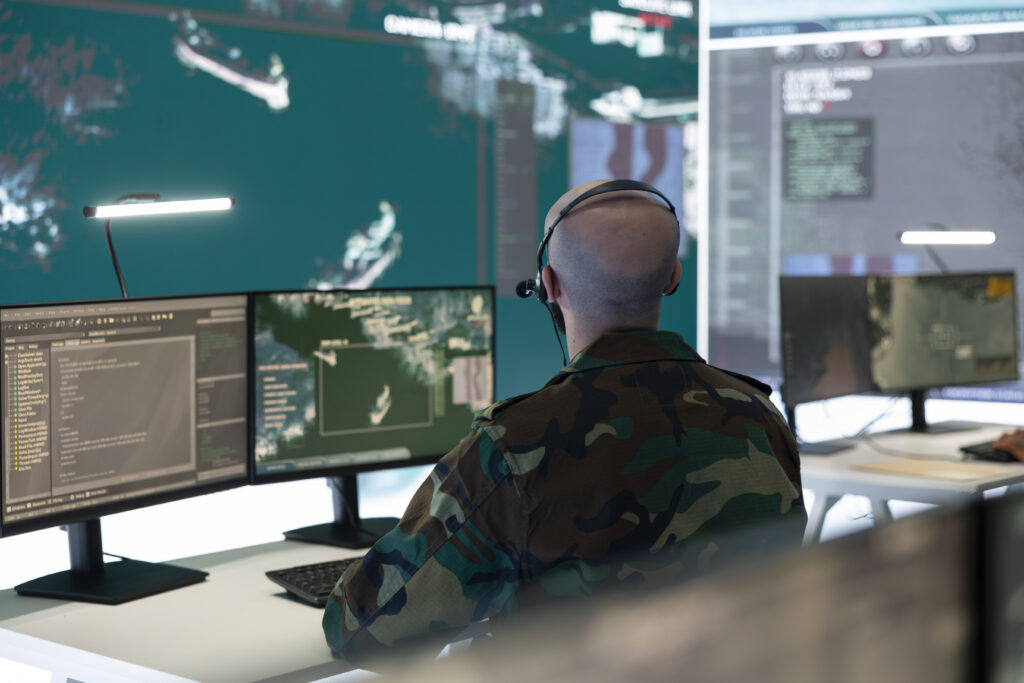Electronic Warfare TrainingThe invisible battlefield of electronic warfare demands a new generation of aviators equipped with cutting-edge skills and technology
In the darkened cockpit of an F-35 Lightning II, Captain Sarah Mitchell watches her multi-function displays flicker with electronic signatures that would have been unimaginable to pilots just a decade ago. Enemy radar systems probe for her aircraft while she simultaneously jams their communications and analyzes their electronic emissions. This is the reality of modern air combat – a complex chess match played at the speed of light across the electromagnetic spectrum.
Electronic warfare (EW) has evolved from a supporting capability to the cornerstone of modern military aviation. Today’s fighter pilots must master an invisible battlefield where victory often depends not on who shoots first, but on who controls the electromagnetic domain most effectively. The training required to prepare aviators for this reality represents one of the most sophisticated educational challenges in military aviation.
The Evolution of Electronic Warfare Training
The transformation of Electronic Warfare training reflects the rapid evolution of threats and technologies. During the Cold War, electronic warfare was primarily defensive – pilots learned to recognize radar lock-on tones and deploy chaff and flares to evade surface-to-air missiles. Modern Electronic Warfare training encompasses a far broader spectrum of offensive and defensive capabilities.
“Twenty years ago, we taught pilots to react to electronic threats,” explains Colonel James Rodriguez, former director of the USAF Weapons School’s EW division. “Today, we’re teaching them to think electronically – to see the electromagnetic spectrum as a battlefield they can dominate.”
This paradigm shift has necessitated a complete overhaul of training methodologies. Modern fighter pilots must understand not just how to operate their aircraft’s electronic warfare systems, but how to integrate EW tactics into every aspect of their mission planning and execution.
Advanced Simulation: The Foundation of Electronic Warfare Training
The complexity and cost of modern electronic warfare systems make live training extremely challenging. Advanced simulation has therefore become the backbone of EW pilot education. The latest generation of EW simulators creates immersive electromagnetic environments that replicate real-world threat scenarios with unprecedented fidelity.
At Nellis Air Force Base, the Distributed Mission Operations (DMO) network links multiple simulation sites across the United States, allowing pilots to train against sophisticated, realistic electronic threats without leaving their home bases. These systems can simulate everything from simple radar jamming to complex, multi-layered integrated air defense systems (IADS) that mirror those found in contested environments worldwide.
The simulation fidelity extends beyond simple radar representations. Modern Electronic Warfare trainers model atmospheric propagation effects, terrain masking, and even the electromagnetic signature variations that occur as systems age or are modified in the field. Pilots experience the full spectrum of electronic warfare – from initial threat detection through successful mission completion or electronic defeat.
Threat Replication and Red Team Operations
Understanding the enemy is fundamental to electronic warfare success. Modern EW training programs employ sophisticated threat replication systems that mirror the capabilities of potential adversaries with remarkable accuracy. These systems don’t simply approximate enemy capabilities – they replicate the exact electromagnetic signatures, operating procedures, and tactical employment patterns of foreign systems.
The 57th Adversary Tactics Group at Nellis AFB operates some of the military’s most sophisticated threat replication equipment. Their systems can mimic Russian S-400 surface-to-air missiles, Chinese Type 052D destroyer radars, and even emerging threats that intelligence agencies have identified but that haven’t yet been encountered in combat.
Red team operations play a crucial role in this training ecosystem. Experienced EW specialists operate these threat systems during training exercises, employing realistic tactics and operating procedures. They study foreign doctrine, analyze captured equipment, and continuously update their threat presentations to reflect the latest intelligence.
“We’re not just pushing buttons to turn on threat emitters,” explains Major Lisa Chen, an Electronic Warfare Training instructor with the 57th ATG. “We’re thinking like our adversaries, employing their tactics, and adapting to student responses the way real enemies would.”
Integration with Fifth-Generation Aircraft Systems
The advent of fifth-generation fighter aircraft like the F-22 Raptor and F-35 Lightning II has revolutionized electronic warfare training. These platforms integrate EW capabilities so thoroughly into their basic design that traditional distinctions between flying the aircraft and operating its electronic systems have largely disappeared.
F-35 pilots, for example, must master the aircraft’s Advanced Electronic Attack (AEA) capabilities, which allow them to detect, analyze, and jam enemy systems while remaining virtually invisible to radar. The training challenge lies not just in operating these systems, but in understanding how to integrate them seamlessly with kinetic weapons and coordinated multi-aircraft operations.
The F-35’s Distributed Aperture System (DAS) provides 360-degree infrared coverage and missile warning capabilities, but it also serves as an electronic warfare sensor. Pilots must learn to interpret the vast amounts of information these systems provide and make split-second tactical decisions based on electronic intelligence that previous generations of aviators never possessed.
Similarly, the F-22’s Advanced Electronic Warfare Suite provides both offensive and defensive capabilities that must be mastered alongside the aircraft’s air-to-air combat systems. Raptor pilots train extensively on coordinating their electronic attacks with their stealth characteristics and kinetic weapons to create layered tactical advantages.
Cognitive Load Management in Electronic Warfare Training Operations
One of the most significant challenges in modern EW training is managing the cognitive load placed on pilots. Electronic warfare systems generate enormous amounts of information, much of it critical to mission success and pilot survival. Training programs must prepare pilots to process this information rapidly while simultaneously flying their aircraft in contested airspace.
Cognitive load management training begins with basic information prioritization. Pilots learn to distinguish between critical, important, and merely interesting electronic information. They practice filtering techniques that allow them to focus on immediate threats while maintaining awareness of the broader electromagnetic picture.
Advanced training scenarios deliberately overload pilots with information to build their capacity for managing complex electronic environments. These exercises might combine multiple simultaneous threats, friendly jamming operations, and communication requirements to create realistic decision-making pressure.
“We’re essentially training pilots to think in multiple domains simultaneously,” explains Dr. Amanda Foster, a cognitive psychologist who works with Air Force EW training programs. “They must maintain spatial awareness, monitor aircraft systems, communicate with teammates, and process electronic warfare information – all while flying at 500 miles per hour in potentially hostile airspace.”

Multi-Domain Training Integration
Modern electronic warfare cannot be separated from operations in other domains. EW training increasingly emphasizes integration with cyber operations, space assets, and ground-based electronic systems. Pilots must understand how their airborne EW activities support and are supported by operations across all domains.
Joint training exercises now routinely include cyber warriors, space operators, and ground-based EW specialists. Fighter pilots might coordinate their electronic attacks with simultaneous cyber operations against the same target systems, or they might depend on space-based intelligence to identify and prioritize electronic threats.
This multi-domain approach extends to training scenarios. A typical modern EW exercise might begin with space-based intelligence identifying enemy radar systems, progress through cyber operations to disrupt command and control networks, and culminate with airborne electronic attacks that exploit the vulnerabilities created by earlier operations.
Live Training and Red Flag Exercises
While simulation provides the foundation for EW training, live exercises remain essential for developing real-world proficiency. Red Flag exercises at Nellis Air Force Base incorporate sophisticated electronic warfare scenarios that test pilots against realistic threat replications in actual flight conditions.
The Nevada Test and Training Range provides a unique environment for live EW training. Its vast size accommodates multiple simultaneous electronic warfare scenarios, while its restricted airspace allows the use of electronic systems that would interfere with civilian operations elsewhere.
During Red Flag exercises, pilots face dynamic, adaptive threats that respond to their tactics in real-time. Enemy threat systems are operated by experienced adversary pilots who study participant tactics between missions and adapt their electronic warfare employment accordingly. This creates an environment where no single tactical approach remains effective throughout the exercise.
International participation in Red Flag exercises adds additional training value. Allied pilots bring different aircraft, electronic warfare systems, and tactical approaches, creating opportunities for cross-training and interoperability development that would be impossible in single-service exercises.
Specialized EW Training Schools and Courses
The complexity of modern electronic warfare has led to the development of specialized training institutions focused exclusively on Electronic Warfare Training education. The USAF Weapons School at Nellis AFB offers an intensive EW instructor course that produces the Air Force’s most expert electronic warfare tacticians.
This six-month course combines academic instruction, simulation training, and live flying to create pilots capable of planning and leading complex electronic warfare operations. Students study foreign threats in detail, learn to develop electronic warfare tactics for specific scenarios, and practice integrating EW operations with broader air campaign planning.
The Navy’s TOPGUN school has similarly evolved to emphasize electronic warfare training. Naval aviators now spend significant portions of their advanced training learning to operate in dense electronic environments similar to those they would encounter in conflicts with near-peer adversaries.
International training exchanges play an increasingly important role in Electronic Warfare Training education. American pilots train alongside allies who operate different electronic warfare systems, learning to coordinate operations across multiple platforms and national systems. These exchanges also expose pilots to different tactical approaches and threat assessments that broaden their understanding of electronic warfare employment.

Technology Integration and Continuous Learning
The rapid pace of electronic warfare technology development requires training programs that emphasise continuous learning rather than mastery of static systems. Modern EW training focuses on teaching principles and concepts that remain relevant even as specific technologies evolve.
Artificial intelligence is increasingly integrated into both Electronic Warfare training systems and training programs. Pilots must learn to work with AI-assisted threat analysis systems that can process electronic intelligence faster than human operators. They also train with AI-powered threat emulators that adapt their behavior based on pilot responses, creating more realistic training scenarios.
Virtual and augmented reality technologies are transforming Electronic Warfare training by allowing pilots to visualize the electromagnetic spectrum in ways that were previously impossible. These systems can display radar coverage patterns, jamming effectiveness, and electronic threat vectors as three-dimensional overlays on the pilot’s view of the physical world.
Assessment and Qualification Standards
Measuring proficiency in electronic warfare requires assessment methods that go beyond traditional flying skills evaluation. Modern Electronic Warfare Training qualification standards incorporate scenario-based evaluations that test decision-making under electronic attack, tactical employment of EW systems, and integration of electronic warfare with kinetic operations.
Standardised scenarios ensure consistent evaluation across different training units and aircraft types. These scenarios are regularly updated to reflect emerging threats and new tactical developments, ensuring that qualification standards remain relevant to current operational requirements.
Continuation training requirements recognise that electronic warfare training skills degrade rapidly without regular practice. Pilots must demonstrate continued proficiency in Electronic Warfare Training operations through regular simulator sessions, academic updates, and live flying exercises that incorporate electronic warfare elements.
Future Directions in Electronic Warfare Training
The future of electronic warfare training will be shaped by emerging technologies and evolving threat environments. Quantum computing may eventually enable electronic warfare systems that operate beyond current human comprehension speeds, requiring new training approaches that emphasize human-machine teaming rather than direct human control.
Machine learning systems are being developed that can automatically adapt electronic warfare tactics based on enemy responses, potentially requiring pilots to shift from tactical operators to strategic supervisors of automated systems. Training programs are beginning to explore how to prepare pilots for this transition while maintaining the human judgment necessary for complex operational decisions.
The proliferation of electronic warfare capabilities to non-state actors and smaller military forces is creating new training requirements. Pilots must prepare for electronic threats in environments previously considered permissive, and they must understand how to operate when traditional electronic warfare advantages are reduced or eliminated.
Conclusion
The evolution of electronic warfare training reflects the fundamental transformation of modern air combat. Today’s fighter pilots operate in an electromagnetic environment that would have been incomprehensible to previous generations of aviators. Their training must prepare them not just to survive in this environment, but to dominate it.
Success in modern electronic warfare requires a combination of technical knowledge, tactical understanding, and split-second decision-making ability that pushes human capabilities to their limits. The training systems that develop these skills represent some of the most sophisticated educational technologies ever created, combining advanced simulation, threat replication, and live training in ways that produce aviators capable of operating in the most contested environments on Earth.
As electronic warfare continues to evolve, so too must the training that prepares pilots to master it. The invisible battlefield of the electromagnetic spectrum demands warriors who can think at the speed of light while flying at the speed of sound – a challenge that will continue to drive innovation in military training for decades to come.
The stakes could not be higher. In future conflicts, victory may well belong to the side that best masters the electromagnetic domain. The fighter pilots training today in advanced electronic warfare scenarios may hold the key to maintaining air superiority in an era where traditional advantages are increasingly challenged by sophisticated electronic threats.
Their preparation for this invisible battle represents one of the most critical investments in national security – ensuring that when the electronic warfare switch is flipped, American pilots will be ready to dominate the spectrum and complete their missions successfully, no matter how contested the electromagnetic environment may be.
Some important references
Official Military/Government Sources:
- U.S. Air Force Official – https://www.af.mil/
- Link when mentioning: “U.S. Air Force training programs”
- Nellis Air Force Base – https://www.nellis.af.mil/
- Link when mentioning: “Red Flag exercises at Nellis Air Force Base”
- U.S. Navy TOPGUN – https://www.navy.mil/Resources/Fact-Files/Display-FactFiles/Article/2169795/us-navy-fighter-weapons-school-topgun/
- Link when mentioning: “Navy’s TOPGUN school”
Defense Contractors:
- Boeing F-35 Page – https://www.boeing.com/defense/f-35-lightning-ii/
- Link when mentioning: “F-35 Lightning II capabilities”
- Lockheed Martin F-22 – https://www.lockheedmartin.com/en-us/products/f-22.html
- Link when mentioning: “F-22 Raptor electronic warfare systems”
Aviation Publications:
- Aviation Week – https://aviationweek.com/defense-space
- Link when discussing: “latest developments in military aviation”
Relative Content
1. Fighter Jets Category
URL: /fighter-jets/ (category page) Where to link: When mentioning “modern fighter aircraft” or “fifth-generation fighters” Anchor text: “advanced fighter jets” or “modern fighter aircraft”
2. Russian Fighter Jets Article
URL: /russian-fighter-jets/ Where to link: When discussing threat replication or adversary aircraft Anchor text: “Russian fighter jets like the Su-57” or “potential adversary aircraft”
3. Advanced Aircraft Technology Article
URL: /advanced-aircraft-tech-us-military/ Where to link: When mentioning F-22 Raptor or stealth technology Anchor text: “advanced aircraft technologies” or “cutting-edge military aviation”
4. Top 10 Modern Russian Military Aircraft
URL: /top-10-modern-russian-military-aircraft/ Where to link: When discussing threat systems or enemy capabilities Anchor text: “modern Russian military aircraft” or “adversary aircraft systems”
5. Nellis Air Force Base Guide
URL: /nellis-air-force-base-afb-space-a-travel-guide/ Where to link: When mentioning Red Flag exercises or Nellis AFB Anchor text: “Nellis Air Force Base” or “learn more about Nellis AFB”
6. J-10 Chengdu Fighter Jet
URL: /the-j-10-chengdu-fighter-jet-a-thread-in-air/ Where to link: When discussing international threats or Chinese aircraft Anchor text: “Chinese fighter aircraft” or “international adversary systems”


